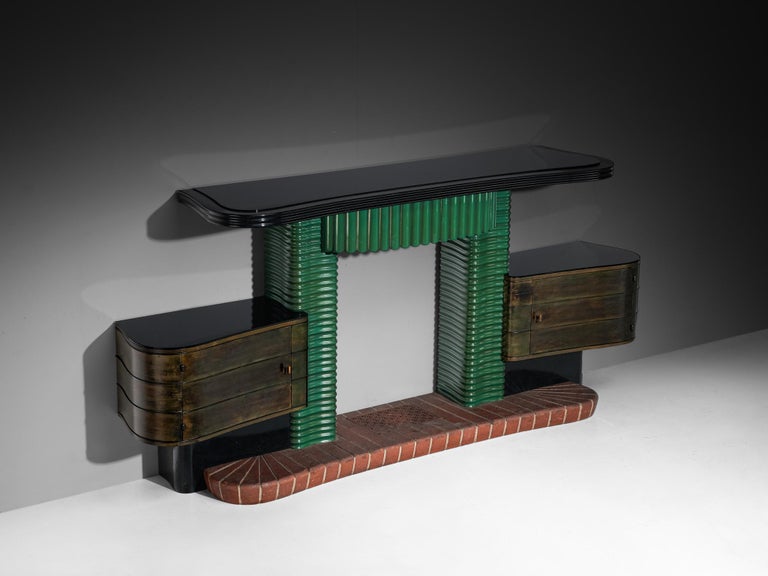









Ernesto Valabrega for Studio Vittorio Valabrega Decorative Fireplace Mantel
Ernesto Valabrega for Studio Vittorio Valabrega, decorative fireplace mantel, lacquered wood, plaster, glass, iron, Italy, 1930s
This striking decorative fireplace mantel, presumably unique, designed by Ernesto Valabrega and manufactured by Studio Vittorio Valabrega in the 1930s in Torino, Italy, is a masterpiece of the Art Deco period. Its bold, sculptural forms and exquisite craftsmanship exemplify the beauty of that particular era in design. The fireplace combines a harmonious mix of colors, including rich green lacquered wood for the ribbed columnar supports, lacquered wood in gold tones for the curved side compartments, and glossy black accents that add dramatic contrast. The hearth base is finished with terracotta colored tiles in a warm, earthy tone, perfectly complementing this refined piece.
Italian designer Ernesto Valabrega (1901-1944) was born in Turin, as the son of celebrated designer and cabinetmaker Vittorio Valabrega (1861-1952).
His father Vittorio was, together with his brother, the founder of Fratelli Valabrega (Valabrega Brothers Company, since 1884) that was situated in Turin. During the 1890s, Vittorio became the sole owner of the company and had great success with his refined wooden furniture. Vittorio Valabrega became well-known for his furniture in the floral Art Nouveau style, but as a true child of the 19th century, his company also manufactured furniture in Neo-Renaissance and the French Rococo Louis XV-style. His designs received positive attention and were awarded at World Exhibitions. At the famous exhibition in Paris in 1900, Vittorio even received a gold medal.
It was at the age of 24 that Ernesto got on board with his father’s business. His involvement from 1925 onwards had a great impact on the company. Ernesto decided to change the company’s name to Mobilart in 1928 and radically redirected the course. Whereas Vittorio was inspired by a variety of contemporary and historic styles, Ernesto chose for a different approach. He renounced the 19th century mixture of styles and approached furniture design in the same manner as the highly influential William Morris of the English Arts and Crafts movement. Their reform was an artistic reaction to the widespread industrialization of the 19th century.
Ernesto despised products of poor quality and chose high quality materials that would last a lifetime. The furniture he created in the late 1920 and 1930s are a true testament to his beliefs. With his irregular carvings of oakwood, the hammered hinges, flowing edges, embossed surfaces his furniture shows quality, attention to detail and ultimate craftsmanship.
Kindly note that this item is in good, used condition.
VAT within the EU: When buying or delivering an item within the EU, VAT usually applies and will be added.
Choose options










Product Details